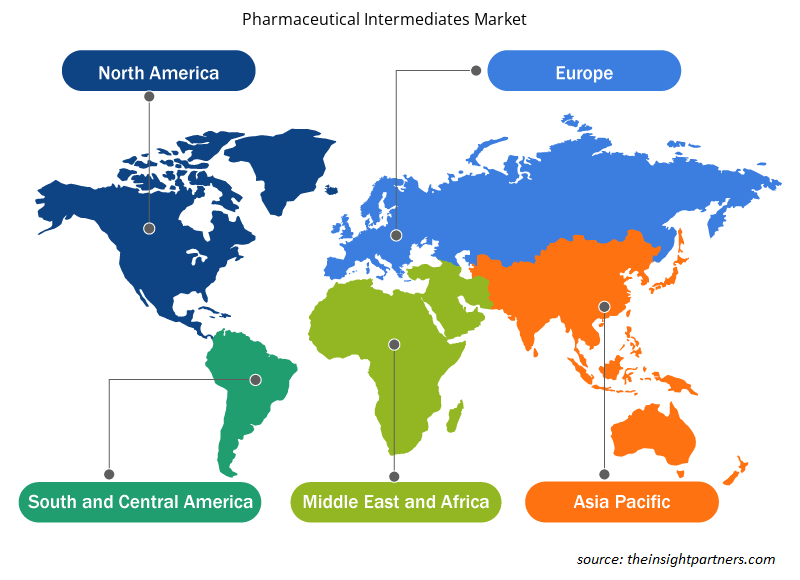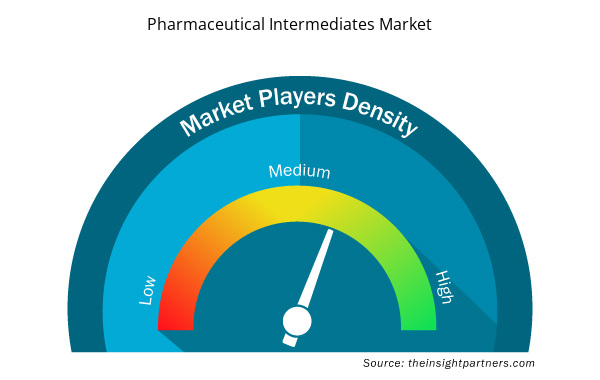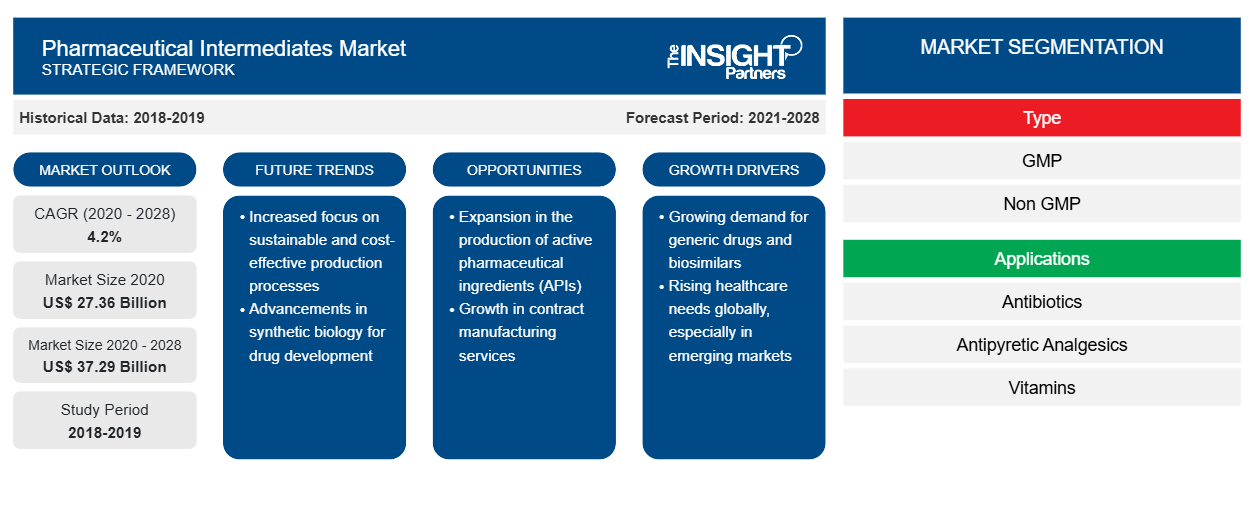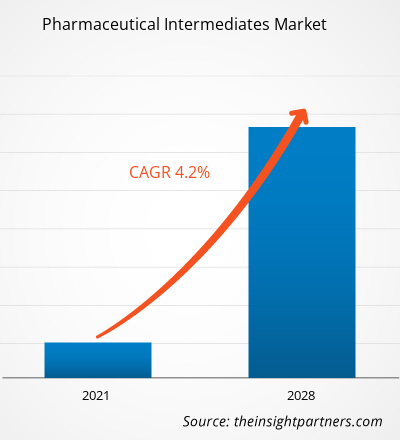Se espera que el mercado de productos intermedios farmacéuticos alcance los 37.290,33 millones de dólares en 2028, frente a los 27.356,70 millones de dólares en 2020. Se estima que el mercado crecerá a una CAGR del 4,2 % entre 2021 y 2028.
El mercado de productos intermedios farmacéuticos se ha analizado en función del tipo, la aplicación, el canal de distribución y la región. El mercado, según la región, está segmentado en América del Norte, Europa, Asia Pacífico, Oriente Medio y África, y América del Sur y Central. El informe hace hincapié en parámetros como las tendencias del mercado, los avances tecnológicos, la dinámica del mercado y el análisis del panorama competitivo de las empresas líderes para ofrecer información y un análisis en profundidad del mercado de productos intermedios farmacéuticos. También incluye el análisis de la pandemia de COVID-19 en todo el mercado en todas las regiones clave.
Personalice este informe según sus necesidades
Obtendrá personalización en cualquier informe, sin cargo, incluidas partes de este informe o análisis a nivel de país, paquete de datos de Excel, así como también grandes ofertas y descuentos para empresas emergentes y universidades.
- Obtenga las principales tendencias clave del mercado de este informe.Esta muestra GRATUITA incluirá análisis de datos, desde tendencias del mercado hasta estimaciones y pronósticos.
Perspectivas del mercado
Aumento de la prevalencia de enfermedades crónicas y enfermedades infecciosas
Los intermediarios farmacéuticos son los componentes básicos de los ingredientes farmacéuticos activos (API). Se trata de materias primas que sufren cambios moleculares o procesamiento durante la producción de medicamentos a granel. Por lo tanto, la necesidad de intermediarios farmacéuticos aumenta con el aumento de la demanda de medicamentos para tratar enfermedades crónicas. Según los Centros para el Control y la Prevención de Enfermedades (CDC), 6 de cada 10 adultos en los EE. UU. sufren al menos una enfermedad crónica, como cáncer, enfermedades cardíacas, enfermedades pulmonares, accidentes cerebrovasculares, enfermedades neurológicas, diabetes y enfermedades renales. Además, 4 de cada 10 adultos en el país tienen dos o más enfermedades crónicas. Además, según el comunicado de prensa de la Alianza Europea de Enfermedades Crónicas (ECDA), en 2014, 9 de cada 10 personas en Europa murieron debido a enfermedades crónicas. Por lo tanto, el 70-80% de los costos totales de atención médica se gastan en el manejo de enfermedades crónicas.
Es probable que la creciente prevalencia de enfermedades infecciosas, especialmente en el sudeste asiático, también impulse la demanda de API en los próximos años, lo que a la larga impulsará el crecimiento del mercado de intermediarios farmacéuticos. Por ejemplo, según el Informe revisado del Programa Nacional de Control de la Tuberculosis, alrededor de 440.000 pacientes murieron debido a la tuberculosis en la India en 2018, es decir, el 29% del total de 1,5 millones de muertes causadas por la enfermedad en todo el mundo. Por lo tanto, una prevalencia tan alta de enfermedades crónicas y enfermedades infecciosas está impulsando la demanda de medicamentos, lo que finalmente pone de relieve la necesidad de intermediarios farmacéuticos.
Perspectivas basadas en tipos
El mercado de productos intermedios farmacéuticos , por tipo, está segmentado en GMP y no GMP. El segmento GMP tuvo la mayor participación del mercado en 2020, mientras que se prevé que el mismo segmento registre la CAGR más alta del mercado del 4,4 % durante el período de pronóstico.
Perspectivas basadas en aplicaciones
El mercado de productos intermedios farmacéuticos, por aplicación, está segmentado en antibióticos, analgésicos antipiréticos, vitaminas y otros. El segmento de antibióticos tuvo la mayor participación del mercado en 2020, además, se prevé que este segmento registre la CAGR más alta del mercado del 4,9% durante el período de pronóstico.
Información basada en canales de distribución
Sobre la base del canal de distribución, el mercado de productos intermedios farmacéuticos se ha segmentado en distribuidor y ventas directas. El segmento de ventas directas tuvo la mayor participación del mercado en 2020, y se estima que el segmento de distribuidores registrará la CAGR más alta del mercado, del 4,2 %, durante el período de pronóstico.
Las empresas que operan en el mercado de productos intermedios farmacéuticos están adoptando estrategias orgánicas como lanzamientos y expansiones de productos para expandir su presencia y cartera de productos en todo el mundo, así como para abordar las crecientes demandas.
Perspectivas regionales del mercado de productos intermedios farmacéuticos
Los analistas de Insight Partners explicaron en detalle las tendencias y los factores regionales que influyen en el mercado de productos intermedios farmacéuticos durante el período de pronóstico. Esta sección también analiza los segmentos y la geografía del mercado de productos intermedios farmacéuticos en América del Norte, Europa, Asia Pacífico, Oriente Medio y África, y América del Sur y Central.

- Obtenga datos regionales específicos para el mercado de productos intermedios farmacéuticos
Alcance del informe sobre el mercado de productos intermedios farmacéuticos
| Atributo del informe | Detalles |
|---|---|
| Tamaño del mercado en 2020 | US$ 27.36 mil millones |
| Tamaño del mercado en 2028 | US$ 37,29 mil millones |
| CAGR global (2020-2028) | 4,2% |
| Datos históricos | 2018-2019 |
| Período de pronóstico | 2021-2028 |
| Segmentos cubiertos | Por tipo
|
| Regiones y países cubiertos | América del norte
|
| Líderes del mercado y perfiles de empresas clave |
|
Densidad de actores del mercado de productos intermedios farmacéuticos: comprensión de su impacto en la dinámica empresarial
El mercado de productos intermedios farmacéuticos está creciendo rápidamente, impulsado por la creciente demanda de los usuarios finales debido a factores como la evolución de las preferencias de los consumidores, los avances tecnológicos y una mayor conciencia de los beneficios del producto. A medida que aumenta la demanda, las empresas amplían sus ofertas, innovan para satisfacer las necesidades de los consumidores y aprovechan las tendencias emergentes, lo que impulsa aún más el crecimiento del mercado.
La densidad de actores del mercado se refiere a la distribución de las empresas o firmas que operan dentro de un mercado o industria en particular. Indica cuántos competidores (actores del mercado) están presentes en un espacio de mercado determinado en relación con su tamaño o valor total de mercado.
Las principales empresas que operan en el mercado de productos intermedios farmacéuticos son:
- Pfizer Inc.
- Sanofi
- BASF SE
- Lianhe Tecnología Química Co., Ltd.
- Carbogen de Dishman Amcis Ltd.
Descargo de responsabilidad : Las empresas enumeradas anteriormente no están clasificadas en ningún orden particular.

- Obtenga una descripción general de los principales actores clave del mercado de productos intermedios farmacéuticos
Por tipo
- BPF
- No GMP
Por aplicación
- Antibióticos
- Analgésicos antipiréticos
- Vitaminas
- Otros
Por canal de distribución
- Distribuidor
- Ventas directas
Por geografía
América del norte
- A NOSOTROS
- Canadá
- México
Europa
- Alemania
- Francia
- Italia
- Reino Unido
- España
- Suiza
- Bélgica
- Grecia
- Noruega
- Portugal
- Suecia
- República Checa
- Croacia
- Irlanda
- Dinamarca
- Holanda
- Rusia
- Resto de Europa
Asia Pacífico (APAC)
- Porcelana
- India
- Corea del Sur
- Japón
- Australia
- Resto de APAC
Oriente Medio y África (MEA)
- Sudáfrica
- Arabia Saudita
- Emiratos Árabes Unidos
- Pavo
- Resto de MEA
América del Sur y Central (SCAM)
- Brasil
- Argentina
- Resto de estafa
Perfiles de empresas
- Pfizer, Inc
- Grupo Dishman
- Laboratorios Dextra Limited
- Industrias Sanofi Winthrop SA
- Vertellus Holdings LLC
- BASF SE
- Tecnología Lianhe
- Códice
- Midas Pharma GmbH
- Chiracon GmbH
- Análisis histórico (2 años), año base, pronóstico (7 años) con CAGR
- Análisis PEST y FODA
- Tamaño del mercado Valor/volumen: global, regional, nacional
- Industria y panorama competitivo
- Conjunto de datos de Excel


- Employment Screening Services Market
- Joint Pain Injection Market
- Lyophilization Services for Biopharmaceuticals Market
- Adaptive Traffic Control System Market
- 3D Mapping and Modelling Market
- Flexible Garden Hoses Market
- Ketogenic Diet Market
- Small Internal Combustion Engine Market
- Sleep Apnea Diagnostics Market
- Military Rubber Tracks Market

Report Coverage
Revenue forecast, Company Analysis, Industry landscape, Growth factors, and Trends

Segment Covered
This text is related
to segments covered.

Regional Scope
North America, Europe, Asia Pacific, Middle East & Africa, South & Central America

Country Scope
This text is related
to country scope.
Preguntas frecuentes
The costs of the Pharmaceutical Intermediates are much higher, and they may cost US$ 5–50, or more, per kgs. The cost may also differ from product to product types.
Pharmaceutical intermediates are the raw materials used to manufacture active pharmaceutical ingredients for the final drug formulation. Pharmaceutical intermediates are used in the production of bulk drugs as well as for research and development purpose by various pharm and biopharma companies. Pharmaceutical intermediates are formed at the time of process of production or synthesis of active pharmaceutical ingredients.
Key factors that are driving the market are to rising prevalence of chronic diseases and infectious diseases, and escalating investment by pharmaceutical companies in R&D activities. However, high cost of drug manufacturing hinders the market growth.
Trends and growth analysis reports related to Life Sciences : READ MORE..
The List of Companies - Pharmaceutical Intermediate Market
- Pfizer Inc.
- Sanofi
- BASF SE
- Lianhe Chemical Technology Co., Ltd
- Dishman Carbogen Amcis Ltd
- Codexis
- Midas Pharma GmbH
- chiracon GmbH
- Dextra Laboratories Limited
- Vertellus Holdings LLC
The Insight Partners performs research in 4 major stages: Data Collection & Secondary Research, Primary Research, Data Analysis and Data Triangulation & Final Review.
- Data Collection and Secondary Research:
As a market research and consulting firm operating from a decade, we have published and advised several client across the globe. First step for any study will start with an assessment of currently available data and insights from existing reports. Further, historical and current market information is collected from Investor Presentations, Annual Reports, SEC Filings, etc., and other information related to company’s performance and market positioning are gathered from Paid Databases (Factiva, Hoovers, and Reuters) and various other publications available in public domain.
Several associations trade associates, technical forums, institutes, societies and organization are accessed to gain technical as well as market related insights through their publications such as research papers, blogs and press releases related to the studies are referred to get cues about the market. Further, white papers, journals, magazines, and other news articles published in last 3 years are scrutinized and analyzed to understand the current market trends.
- Primary Research:
The primarily interview analysis comprise of data obtained from industry participants interview and answers to survey questions gathered by in-house primary team.
For primary research, interviews are conducted with industry experts/CEOs/Marketing Managers/VPs/Subject Matter Experts from both demand and supply side to get a 360-degree view of the market. The primary team conducts several interviews based on the complexity of the markets to understand the various market trends and dynamics which makes research more credible and precise.
A typical research interview fulfils the following functions:
- Provides first-hand information on the market size, market trends, growth trends, competitive landscape, and outlook
- Validates and strengthens in-house secondary research findings
- Develops the analysis team’s expertise and market understanding
Primary research involves email interactions and telephone interviews for each market, category, segment, and sub-segment across geographies. The participants who typically take part in such a process include, but are not limited to:
- Industry participants: VPs, business development managers, market intelligence managers and national sales managers
- Outside experts: Valuation experts, research analysts and key opinion leaders specializing in the electronics and semiconductor industry.
Below is the breakup of our primary respondents by company, designation, and region:

Once we receive the confirmation from primary research sources or primary respondents, we finalize the base year market estimation and forecast the data as per the macroeconomic and microeconomic factors assessed during data collection.
- Data Analysis:
Once data is validated through both secondary as well as primary respondents, we finalize the market estimations by hypothesis formulation and factor analysis at regional and country level.
- Macro-Economic Factor Analysis:
We analyse macroeconomic indicators such the gross domestic product (GDP), increase in the demand for goods and services across industries, technological advancement, regional economic growth, governmental policies, the influence of COVID-19, PEST analysis, and other aspects. This analysis aids in setting benchmarks for various nations/regions and approximating market splits. Additionally, the general trend of the aforementioned components aid in determining the market's development possibilities.
- Country Level Data:
Various factors that are especially aligned to the country are taken into account to determine the market size for a certain area and country, including the presence of vendors, such as headquarters and offices, the country's GDP, demand patterns, and industry growth. To comprehend the market dynamics for the nation, a number of growth variables, inhibitors, application areas, and current market trends are researched. The aforementioned elements aid in determining the country's overall market's growth potential.
- Company Profile:
The “Table of Contents” is formulated by listing and analyzing more than 25 - 30 companies operating in the market ecosystem across geographies. However, we profile only 10 companies as a standard practice in our syndicate reports. These 10 companies comprise leading, emerging, and regional players. Nonetheless, our analysis is not restricted to the 10 listed companies, we also analyze other companies present in the market to develop a holistic view and understand the prevailing trends. The “Company Profiles” section in the report covers key facts, business description, products & services, financial information, SWOT analysis, and key developments. The financial information presented is extracted from the annual reports and official documents of the publicly listed companies. Upon collecting the information for the sections of respective companies, we verify them via various primary sources and then compile the data in respective company profiles. The company level information helps us in deriving the base number as well as in forecasting the market size.
- Developing Base Number:
Aggregation of sales statistics (2020-2022) and macro-economic factor, and other secondary and primary research insights are utilized to arrive at base number and related market shares for 2022. The data gaps are identified in this step and relevant market data is analyzed, collected from paid primary interviews or databases. On finalizing the base year market size, forecasts are developed on the basis of macro-economic, industry and market growth factors and company level analysis.
- Data Triangulation and Final Review:
The market findings and base year market size calculations are validated from supply as well as demand side. Demand side validations are based on macro-economic factor analysis and benchmarks for respective regions and countries. In case of supply side validations, revenues of major companies are estimated (in case not available) based on industry benchmark, approximate number of employees, product portfolio, and primary interviews revenues are gathered. Further revenue from target product/service segment is assessed to avoid overshooting of market statistics. In case of heavy deviations between supply and demand side values, all thes steps are repeated to achieve synchronization.
We follow an iterative model, wherein we share our research findings with Subject Matter Experts (SME’s) and Key Opinion Leaders (KOLs) until consensus view of the market is not formulated – this model negates any drastic deviation in the opinions of experts. Only validated and universally acceptable research findings are quoted in our reports.
We have important check points that we use to validate our research findings – which we call – data triangulation, where we validate the information, we generate from secondary sources with primary interviews and then we re-validate with our internal data bases and Subject matter experts. This comprehensive model enables us to deliver high quality, reliable data in shortest possible time.


 Obtenga una muestra gratuita de este informe
Obtenga una muestra gratuita de este informe